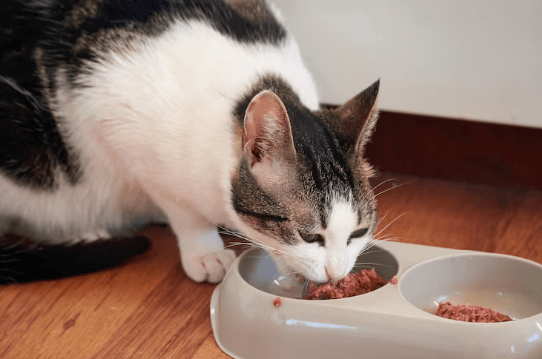In recent years, there has been a growing trend among pet owners to provide their feline companions with a diet that closely mimics what their wild ancestors ate. Raw cat food, often called a “biologically appropriate raw food” or BARF diet, has gained popularity for its purported health benefits.
Cats are obligate carnivores, so they need nutrients derived exclusively from animal protein sources. The Cats Exclusive Veterinary Center recommends that cat owners attempt to replicate this diet at home, as it is species-appropriate and contains moisture and taurine, a crucial amino acid that cats cannot produce internally.
The choice between raw food, canned wet food, and kibble depends on your preference, budget, and your cat’s overall health. But if you’re considering switching your feline friend to a raw food diet, here are a few things to consider.
Biological Appropriateness
Cats, as obligate carnivores, have evolved to thrive on a predominantly meat-based diet. Raw cat food seeks to emulate this natural diet, providing essential nutrients like protein, vitamins, and minerals crucial for your cat’s overall health and vitality. A raw diet promotes a robust and well-balanced lifestyle for your feline companion by aligning with their biological needs.
Nutritional Benefits
Rich in muscle, meat, organs, and bones, raw diets provide a well-rounded mix of proteins, fats, and micronutrients. This comprehensive nutritional profile can contribute to healthier skin and coat, improved digestion, and better weight management, ensuring your cat receives the fundamental components necessary for optimal well-being and longevity.
Allergies and Sensitivities
Many commercial cat foods incorporate additives, preservatives, and fillers that can trigger allergies or sensitivities in some cats. A raw diet eliminates these potential allergens, making it a suitable option for cats with food sensitivities.
If you feed your pet a more natural diet, like raw cat food, you can potentially reduce the exposure to artificial additives that might exacerbate allergic reactions, as long as you choose a reputable company experienced in creating raw pet food. This shift towards a more natural approach addresses sensitivities and promotes overall wellness by aligning with your cat’s biological needs.
Nevertheless, it is crucial to consult with a veterinarian before significantly changing your cat’s diet. A personalized approach will help address individual health needs and ensure a smooth transition to a raw diet without compromising your cat’s well-being.
Digestive Enzymes and Gut Health
Raw cat food is believed to contain natural digestive enzymes that facilitate the breakdown and absorption of nutrients. This can be particularly beneficial for cats with digestive issues. Additionally, the absence of processed ingredients may contribute to a healthier gut microbiome, promoting overall digestive health and potentially alleviating gastrointestinal concerns.
While the scientific community continues to explore these potential benefits, anecdotal evidence suggests improvements in digestion and nutrient absorption for cats on a raw diet.
Weight Management
Obesity remains a prevalent issue among domesticated cats, present in as many as 63 percent of cats in developed nations. Being overweight can impact their overall health and well-being. Raw diets, when appropriately balanced, can contribute to weight management. The high protein content helps maintain lean muscle mass, and the absence of unnecessary carbohydrates may prevent excessive weight gain.
However, it is crucial to tailor the diet to your cat’s specific needs, considering factors like age, activity level, and overall health. Regular monitoring and adjustments are vital to achieving and maintaining a healthy weight for your feline friend.
Dental Health
Feeding your cat a raw diet, including bones, can positively affect dental health. Chewing on bones promotes natural dental abrasion, helping to reduce tartar and plaque buildup. This fosters healthier teeth and gums, potentially mitigating dental issues commonly faced by cats. However, selecting appropriate bones to avoid choking hazards or splintering is imperative, ensuring a safe and effective dental health solution.
Improved Hydration
Raw cat food often contains a higher moisture content compared to dry kibble. In the wild, cats obtain a significant portion of their hydration from the prey they consume. By incorporating raw meat into your cat’s diet, you are providing them with a moisture-rich source of nutrition. This increased water content can contribute to better hydration, essential for kidney function, urinary tract health, and overall well-being.
Adequate hydration is particularly crucial for cats, as they have a lower thirst drive than other animals, making them prone to dehydration. Including raw food in their diet can be a proactive measure to ensure your feline friend stays properly hydrated, supporting their urinary health and overall vitality. As always, monitoring your cat’s water intake and consulting with your veterinarian to tailor their diet to their specific needs is essential.
Concerns and Controversies
While proponents of raw cat food emphasize its benefits, critics raise legitimate concerns about potential health risks. Raw meat can harbor bacteria such as Salmonella and E. coli, posing health risks to cats and their owners. Ensuring the quality and safety of raw ingredients is paramount to mitigating these risks.
Thoroughly researching reputable suppliers and following proper handling and hygiene practices, including storing and preparing raw food safely, can help minimize the potential dangers of a raw diet. It’s also essential to be aware of the zoonotic risks, considering the possible transmission of pathogens from pets to humans.
Transitioning to a Raw Diet
switching your cat to a raw diet should be a gradual and thoughtful process. Abrupt changes can lead to digestive upset, and it’s essential to ease your cat into the new diet. Begin by introducing small amounts of raw food alongside your cat’s regular diet, gradually increasing the proportion of raw food over time.
Monitor your cat’s health, behavior, and consult with a veterinarian throughout the transition to address any issues promptly and ensure a smooth adjustment to the new diet. Individual cats may have varying preferences and tolerances, so patience and observation are crucial during this period of change.
Conclusion
Feeding your feline friend a raw diet is a decision that requires careful consideration, research, and consultation with a veterinarian. While there are potential benefits, it’s essential to be aware of the associated risks and take appropriate measures to ensure the safety and well-being of your pet.
Ultimately, the choice between raw and commercial cat food depends on your cat’s needs, health conditions, and ability to provide a balanced and safe raw diet tailored to their specific requirements. With the right approach and attention to detail, a raw diet can be a purr-fectly nourishing choice for your beloved feline companion.

